
@utomated Entertainment HD Dichroic™
Thin Film Coating Specifications

Color Filters
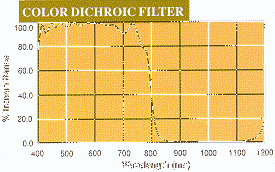 Dichroic color filter coatings are an excellent alternative to dyed plastics and glass. Unlike plastic color gels which age and breakdown relatively quickly during use, dichroic filters
are designed to stand up to the heat and UV energy in high energy light sources.
Dichroic color filter coatings are an excellent alternative to dyed plastics and glass. Unlike plastic color gels which age and breakdown relatively quickly during use, dichroic filters
are designed to stand up to the heat and UV energy in high energy light sources.
High energy light sources can also have a damaging affect on dyed glasses as well due to their heat absorbing nature. Dichroic color filters have the advantage of reflecting unwanted light instead of absorbing the energy, which allows dichroic filters to be used with much higher intensity light sources.
Dichroic color filters are used in a variety of applications including architectural, entertainment, science, and engineering. Many industry standard colors have been engineered as dichroic filters. However, we would be happy to review any custom color coatings needed to complete your project.

Band Pass Color Filters:
These filter coatings transmit varying wavelength bands, which are determined by two cutoffs-one in the long and one in the short wavelength. Filters can be made at any given wavelength from near ultraviolet to near infrared.
Other Coatings Available: Color Corrective Filters (CTO & CTB)
0º Hot Mirror & 45º Cold Mirror
Heat control coatings perform a very important function in high energy optical systems. Applications such as medical lighting, curing of dyes and cements, and projection systems are all examples where heat control filters are often vital.
Broad band optical sources often produce unwanted heat energy along with the light energy needed in the system. Heat control coatings provide an excellent way to separate heat from light.
In general, there are two filter types for performing this separation. The first filter type is called a HOT MIRROR. As the name implies, hot mirrors are used to reflect heat energy, infra-red energy, away from the optical system while allowing the light energy to pass. Hot mirrors are a very good solution
when size and geometry of the system are of concern.
COLD MIRRORS are the second filter type for separating heat from light energy. Cold mirrors are generally placed at an angle to the light path in the system. When the energy from the light source strikes the cold mirror, the light energy is reflected into the system while the heat energy is allowed to pass through. This method is excellent
for removing as much heat as possible from the optical path.
Automated carries a variety of standard hot and cold mirror filters. Our standard substrate materials are fused silica and Borosilicate glasses. However, custom substrates are not a problem. Let us know how we can help eliminate heat from your optical system.
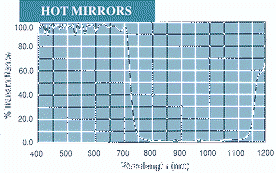
Hot Mirror
These "hot mirror" filters transmit the visible spectrum and reflect the infrared. At any specified angle of incidence, the average transmission is more than 93% from 425 to 675 nm. The average reflectance of our standard Hot Mirror is more than 95% from 750 to 1150 nm.
Extended Hot Mirror: The average reflectance is more than 90% from 750 to 1600 nm.
Long IR Hot Mirror The average reflectance is more than 90% from 1700 to 3000 nm.
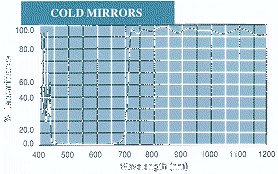
Cold Mirror
These "cold mirror" filters reflect the visible spectrum
and transmit heat (infrared). At any specified angle of
incidence, average reflectance is more that 95% from
450 to 675 nm. Transmission is more than 85% from
800 to 1200 nm.
UV
Blockers: Block out harmful UV that can be damaging to pigment and dyed products such as fabric, photos, antiquities, paints and polyesters. Harmful UV from long exposure to high powered short arc units can also effect human skin and eyes by burning or irritating them. Automated Entertainment offers two types of the
UV Blockers:
UV B&C BLOCKER reflects or blocks 99% average of the extremely harmful UV radiation from 200-320 nm and transmits greater than 90% average from 340-800 nm through the visible spectrum.
100% UV BLOCKER reflects or blocks 99% average of all UV radiation including UV A from 320-380 nm and transmits greater than 90% average across the visible spectrum from 420-800 nm. Both of our UV blockers are color neutral and are just as clear as the glass they are coated on.
Conductive Coatings
Transparent conductive coatings are very often used in electro-magnetic shielding, electrical heating, and cutting edge display applications. We use indium-tin oxide (ITO) which provides for excellent durable coatings.
Often, ITO coatings are used in contact with materials other than air. We can designs and produces ITO coatings designed specifically to be used next to materials such as liquid crystal, cements, index oils, and various other materials. ITO coatings that have been under coated or overcoated to be index matched to a particular material, such
as liquid crystal, can have a very low reflectance.
One determining factor as to how low a reflectance can be achieved is the sheet resistivity specification. Thicker ITO layers yield lower sheet resistivities but also result in higher reflectance. Sheet resistivities as low as 5 to 10 ohms/SQ and as high as a few thousand ohms/SQ can be achieved.
One common thickness of ITO, 100 angstroms, yields about 450 ohms/SQ.
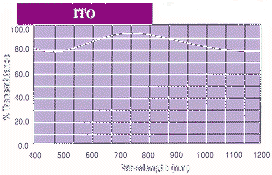
ITO
This coating provides low resistivity of less than 10
ohms per square and is optically transparent over the
visible spectrum (400 to 700 nm) with an average
transmittance of 84%. Higher resistivities are
available upon request.
Covert Infrared & Complex Filters
Our Covert, Semi-Covert, and Blackeye filters are ideally suited for use in conjunction with infra-red cameras, scopes and goggles for surveillance and other nighttime applications. These filters enable light sources and imaging devices to emit and receive infrared energy without drawing attention with the
visible light which would otherwise be seen.
These filters are often kept on the shelf on 24 inch diameter substrates and can be cut down to size per your specifications. We will be happy to be of service in meeting your IR filter needs.
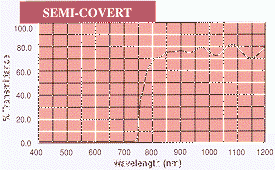 Semi-Covert
Semi-Covert
This filter is made of specially coated optical glass
designed to reduce the visible output of a light source
while allowing infrared output to pass through.
Transmission is <= 1.0% average at 400 to 720 nm
and >= 70% average from 850 to 2500 nm. It is
designed for use with night vision equipment or CCD
cameras for applications such as amusement park
surveillance, airport perimeter security, and building
security.
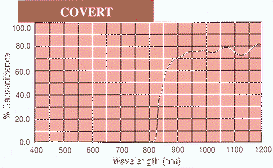
Covert
This specially coated optical glass filter blocks the
visible output from a light source and allows infrared
output to pass through. Transmission is <= 1.0%
average from 400 to 815 nm and >= 70% average
from 900 to 1200 nm. It is designed for use with night
vision equipment of CCD cameras for applications
such as airport security, law enforcement
surveillance, and building security.
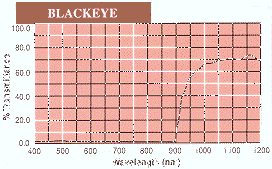
Blackeye
This unique filter consists of a two piece optically coated substrate designed to block the visible output of a light source from as close as 3 feet. Transmission is <= 1.0% average from 400 to 890 nm and >= 65% average from 950 to 2500 nm. Reflectance is <= 5.0% average from 400 to 700 nm. It is ideally suited for use with night vision equipment
or CCD cameras for short or long range surveillance applications.
Ultraviolet Complex Filter (365nm) HD UV Pass Blacklite™
We a variety of filters for the UV region of wavelengths. Popular examples include our UV Pass Hot Mirror used in temperature sensitive applications and our 470nm Short Wave Pass filter used for fluorescence
applications . Currently, we are capable of producing spectral
scans for our UV filters down to 200nm in wavelength.
If your system reflects, transmits, or separates UV energy,
we have just the filters you are looking for.
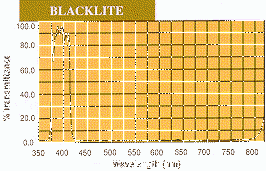
Blacklite
Our HD UV Pass BlackLite Dichroic is a specially coated optical glass filter which transmits 80% peak in the UV range from 340 to 380 nm and blocks light below 315 nm and in the visible range of 400 to 700 nm. It is ideally suited for laser flourescence, police forensics, inspection/quality control, materials testing, and entertainment lighting/visual effects.
Neutral Density Beamsplitters
Beam-Splitter (BS) is a term used to describe various coatings which divide a beam of light into separate beams. Dichroic filters, covered in our Color Filter section, are often called beam-splitters. However, in this section, we will be speaking specifically about beam-splitters that divide light at
each wavelength of interest into the two separate beams with an incident angle around 45 degrees from normal.
Partially transmitting metals make very useful beam-splitter coatings. Two common metals used for this purpose are Inconel and chrome. Metal beamsplitters are often very broad and can cover a much wider spectrum of wavelengths than their dielectric counterparts.
Dielectric coatings, however, have the advantage of being non-absorbing and so allow for greater throughput of energy. For example, a dielectric coating can be used for a 50/50 beam-splitter coating. Inconel, on the other hand, can yield approximately 30% transmission and 30% reflection due to
the absorption inherent in the metal film. Standard dielectric beam-splitter coatings include 30/70, 50/50, and 70/30. However, we would welcome any custom requirements you may have. Please feel free to contact us with your specifications.
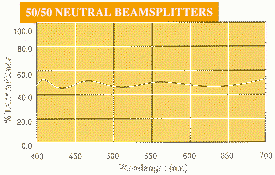
50/50 Neutral Beamsplitter
Designed to transmit 50% and reflect 50% (± 5.0%)
from 450 to 650 nm at 45° angle of incidence. May be
applied to a flat plate or to the diagonal surface of a
cube made from two right-angle prisms cemented
together.

25/75 Neutral Beamsplitter
Transmits 25% and reflects 75% (± 5.0%) from 450 to
650 nm at 45° angle of incidence. For use on flat
plates.
Enhanced Aluminum First Surface Mirrors
Metal coatings are often used in systems where a very broadband reflector or beamsplitter is needed. Metal coatings can also be an excellant choice when an economical coating
is especially important.
Examples of common metal coating applications include telescope mirrors, neutral density filters, and general purpose laboratory mirrors. Metals commonly deposited at our lab include aluminum, chromium, silver, and inconel.
The metal coatings given as examples in this group are meant to give some ideas on what is possible with metal coatings. If your system requires a custom or modified metal coating, we
would be happy to be of service.
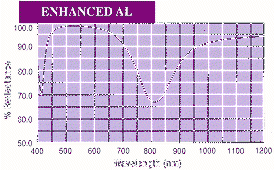
Enhanced AL
The front surface of the enhanced aluminum coating
reflects an average of 93% over the visible spectrum
(425 to 675 nm). It meets durability requirements of
MIL-M-13508C.
Other Coatings Available: Chrome and Silver
Like Our Hard AG: The hard silver coating reflects an average of 96% over the visible spectrum (425 to 675 nm) and greater than 96% in the 700 to 1000 nm range.
Anti-reflection (AR)
AR coatings eliminate reflections at air-glass interfaces and other material boundaries. Reflections at
boundaries between glass and optical cements can also be greatly reduced. This is very useful for cemented optics and optics in contact with liquids such as liquid crystal or water.
AR coatings are often crucial components in optical systems with multiple lenses or other optics where the maximum possible light energy is needed. AR coatings help to produce brighter images. AR coatings also reduce the intensity of ghost images which are sometimes produced in optical systems by multiple reflecting surfaces.
We commonly deposit various standard and custom AR coatings. AR coatings are generally separated into two groups. The first group is made of AR coatings that target one or more broad wavelength bands. Our BARC coatings are examples of this group.
The second group of AR coatings is made of AR coatings that target one or more narrow wavelength bands. The most common coating in this group is termed a Vcoat. Vcoats are
used to target a single wavelength, such as 632.8nm or 532nm, or a single very narrow band of wavelengths.
The coatings on the following pages are only a sample of what is available. Please do not hesitate to contact us if a custom coating would better meet your AR needs.
BARC-5
This high efficiency, broad band anti-reflection coating
reflects less than 0.3% average and 0.5% maximum
absolute from 415 to 700 nm. Refractive indexes are
1.46 to 1.90.
If you don't see the coating that your looking for just ask.
Last Up Date 11/02/02
![]()